TGV PSE (Paris Sud-Est)
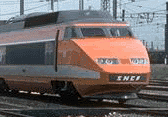
|
Build dates: 1978-1985
Territory: LGV Sud-Est, LGV Rhône-Alpes, LGV
Mediterrannée
Top Speed: 300/270 km/h (186/168 mph)
Number in Service: 107 (see fleet list for
numbering)
Supply Voltages: 25kV 50Hz AC, 1.5kV DC (15kV 16.7Hz for some)
Traction: 12 DC motors, total continuous power
6450 kW (8650 hp) under 25kV supply, 3100 kW (4160 hp) under 1.5kV supply,
2800 kW (3750 hp) under 15kV supply. Almost twice these figures for 7
minutes.
Length and Weight: 200 m / 385 tonnes
Configuration: 1 power car + 8 trailers + 1 power car, 350 seats
(see formations)
Performance Metrics: 17 kW/tonne / 1.10 tonnes/seat / 18.34 kW/seat
Pressure Sealed: No
Spotting Features: Orange livery (original) or blue and silver (for
renovated trainsets). Roof fairing of
locomotive does not extend over cab. See how to tell this
type apart from TGV Réseau or TGV Atlantique trainsets
Images: [TGVweb] [ERS
Picture Gallery]
Special Notes: Trainset 16 set 1981 speed record of 380 km/h (236
mph).
Scale Paper Model: Print, cut out and assemble a 1/140 scale model which
you can get here.
|
|
TGV La Poste

|
Build Dates: 1981-1984
Territory: LGV Sud-Est
Top Speed: 270 km/h (168 mph)
Number in Service: 7 (see fleet list for
numbering)
Supply Voltages: 25kV 50Hz AC, 1.5kV DC
Traction: Same as TGV Sud-Est
Length and Weight: 200 m / 345 tonnes
Configuration: 1 power car + 4 trailers, 0 seats (see formations)
Performance Metrics: 19 kW/tonne
Pressure Sealed: No
Spotting Features: Yellow livery and "La Poste" lettering
Images: [TGVweb]
Special Notes: Always operated in pairs. Carries mail only.
Scale Paper Model: Print, cut out and assemble a 1/140 scale model which
you can get here.
|
|
TGV Atlantique
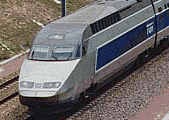
|
Build Dates: 1989-1992
Territory: LGV Atlantique
Top Speed: 300 km/h (186 mph)
Number in Service: 105 (see fleet list for
numbering)
Supply Voltages: 25kV 50Hz AC, 1.5kV DC
Traction: 8 3-phase AC synchronous motors, total power 8800 kW
(12000 hp) under 25kV supply
Length and Weight: 238 m / 484 tonnes
Configuration: 1 power car + 10 trailers + 1 power car, 485 seats
(see formations)
Performance Metrics: 18 kW/tonne / 1.00 tonnes/seat / 18.14 kW/seat
Pressure Sealed: No
Spotting Features: 10 trailers and silver/blue livery, numbering 301
to 405. Don't confuse with PSE or Réseau.
Images: [TGVweb] [ERS Picture Gallery]
Special Notes: Trainset 325 holds world speed record of 515.3 km/h
(320.3 mph). See how to tell this type
apart from TGV Réseau or TGV Paris Sud-Est trainsets
Scale Paper Model: Print, cut out and assemble a 1/140 scale model which
you can get here.
|
|
AVE (Alta Velocidad Española)
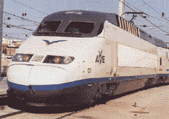
|
Build Dates: 1991-1992
Territory: Madrid-Sevilla high speed line, Spain
Top Speed: 300 km/h (186 mph)
Number in Service: 16
Supply Voltages: 25kV 50Hz AC, 3kV DC
Traction: Same as TGV Atlantique
Length and Weight: 200 m / 392 tonnes
Configuration: 1 power car + 8 trailers + 1 power car (329
seats)
Performance Metrics: 22 kW/tonne / 1.19 tonnes/seat / 26.75 kW/seat
Pressure Sealed: ??
Spotting Features: Rounded nose fairing, white livery. Don't
confuse with Euromed broad-gauge version.
Images: [ERS
Picture Gallery]
Special Notes: The AVE is an exported Spanish TGV, closely derived
from the TGV Atlantique. It runs on German-designed high speed
tracks, and is gauged at the standard 1.435 m (4' 8.5") unlike the
Spanish broad gauge of 1.668 m (5' 5.5").
Scale Paper Model: Print, cut out and assemble a 1/140 scale model which
you can get here.
|
|
TGV Réseau
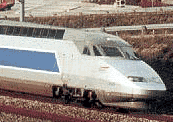
|
Build Dates:1992-1996
Territory: Mostly LGV Nord-Europe, entire TGV network
Top Speed: 300 km/h
Number in Service: 80 (see fleet list for
numbering)
Supply Voltages: 25kV 50Hz AC, 1.5kV DC (3kV DC for some)
Traction: Same as TGV Atlantique
Length and Weight: 200 m / 386 tonnes
Configuration: 1 power car + 8 trailers + 1 power car, 377 seats
(see formations)
Performance Metrics: 23 kW/tonne / 1.02 tonnes/seat / 23.34 kW/seat
Pressure Sealed: Yes
Spotting Features: 8 trailers and silver/blue livery, numbering in
500 or 4500 series. Don't confuse with PSE or Atlantique.
Images: [TGVweb] [ERS
Picture Gallery]
More Information: See article.
Special Notes: Some trainsets are equipped with 3kV DC for
service to Belgium or Italy. See how to tell this
type apart from TGV Paris Sud-Est or TGV Atlantique trainsets
|
|
Eurostar
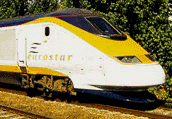
|
Build Dates: 1993-1995
Territory: LGV Nord-Europe and points north
Top Speed: 300 km/h (186 mph)
Number in Service: 31 (see fleet list for
numbering)
Supply Voltages: 25kV 50Hz AC, 3kV DC, 750V DC third rail (1.5kV DC
for some)
Traction:12 3-phase AC asynchronous motors, total power 12200 kW
(16300 hp) under 25kV supply
Length and Weight: 394 m / 752 tonnes
Configuration: 1 power car + 18 trailers + 1 power car, 794 seats
(see formations)
Performance Metrics: 16 kW/tonne / 0.98 tonnes/seat / 15.90 kW/seat
Pressure Sealed: Yes
Spotting Features: yellow duckbill nose, low profile.
Images: [ERS
Picture Gallery]
More Information: See article.
Special Notes: International (40/40/20) cooperation between France,
Britain and Belgium.
|
|
TGV Duplex
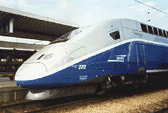
|
Build Dates: 1995-1997
Territory: LGV Sud-Est
Top Speed: 300 km/h (186 mph)
Number in Service: 30 + 12 ordered (1999)
Supply Voltages: 25kV 50Hz AC, 1.5kV DC
Traction: Same as TGV Atlantique
Length and Weight: 200 m / 380 tonnes
Configuration: 1 power car + 8 trailers + 1 power car, 545 seats
(see formations)
Performance Metrics: 23 kW/tonne / 0.70 tonnes/seat / 16.15 kW/seat
Pressure Sealed: Yes
Spotting Features: Bilevel seating, single windshield, rounder
nose
Images: [TGVweb] [ERS
Picture Gallery]
More Information: See article.
Special Notes: Developed to relieve congestion on LGV Sud-Est.
Scale Paper Model: Print, cut out and assemble a 1/140 scale model which
you can get here.
|
|
Thalys
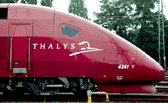
|
Build Dates: 1995-1998
Territory: LGV Nord-Europe and points north
Top Speed: 300 km/h (186 mph)
Number in Service: 27 (see fleet list for
numbering)
Supply Voltages: 25kV 50Hz AC, 1.5kV DC, 3kV DC (15kV 16.7Hz AC for
some)
Traction: Same as TGV Atlantique
Length and Weight: 200 m / 385 tonnes
Configuration: 1 power car + 8 trailers + 1 power car, 377 seats
(see formations).
Performance Metrics: 23 kW/tonne / 1.02 tonnes/seat / 23.34 kW/seat
Pressure Sealed: Yes
Spotting Features: Red/silver livery. PBA trainsets are in 4500 series
and have split windshields, while PBKA trainsets are in 4300 series
and have single windshields.
Images: [TGVweb] [ERS
Picture Gallery]
More Information: See article.
Special Notes: International cooperation between France, Belgium,
the Netherlands, and Germany. Two sub-classes, PBA and PBKA, see how to tell them apart.
Scale Paper Model: Print, cut out and assemble a 1/140 scale model which
you can get here.
|
|
KTX (TGV Korea)

|
Build Dates: 1997-2002
Territory: Line from Seoul to Pusan, Korea
Top Speed: 300 km/h (186 mph)
Number Ordered: 46 (12 made in France)
Supply Voltages: 25kV 50Hz AC
Traction: 12 3-phase AC synchronous motors, total power 13200 kW
(17700 hp)
Length and Weight: 387 m / 701 tonnes
Configuration: 1 power car + 18 trailers + 1 power car, 935
seats. (see formations)
Performance Metrics: 19 kW/tonne / 0.75 tonnes/seat / 14.12
kW/seat
Pressure Sealed: Yes
Spotting Features: Pointy nose, blue/silver livery (blue/white on earlier
models)
Images: [TGVweb]
Special Notes: Part of the order is to be built in South Korea
under a technology transfer agreement.
Scale Paper Model: Print, cut out and assemble a 1/140 scale model which
you can get here.
|
|
TGV P-01 Tilting Demonstrator

|
Existed: 1998 to 2000 (temporary conversion of PSE trainset 101)
Territory: Various
Top Speed: 220 km/h (or 320 km/h in multiple unit)
Number in Service: 0 (converted back to trainset 101 in 2000)
Supply Voltages: 25kV 50Hz AC, 1.5kV DC
Traction: 8 DC motors, total continuous power
4300 kW (5770 hp) under 25kV supply, 2070 kW (2770 hp) under 1.5kV supply.
Almost twice these figures for 7 minutes.
Length and Weight: 200 m / 385 tonnes
Configuration: 1 power car + 8 trailers + 1 power car
Spotting Features: New dark blue and silver livery with large
red side graphics
Images: [TGVweb] [ERS
Picture Gallery]
More Information: See article.
Special Notes: This is an experimental prototype modified by
Alstom to test new tilting technology.
|
|
TGV NG (Nouvelle Génération)
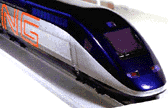
|
Build Dates: 2000+
Territory: All TGV lines
Top Speed: 360 km/h (225 mph)
Number Ordered: 1 (one) power unit
Supply Voltages: 25kV 50Hz AC, other unknown
Traction: 4 3-phase AC asynchronous motors, 6000 kW (8000 hp) under
25kV supply
Length and Weight: 22.15 m / 64 tonnes
Configuration: 1 prototype power unit
Performance Metrics: none available
Spotting Features: none available
Images: [TGVweb]
More Information: See article.
Special Notes: As of late 1999, this project has an unknown future
as ALSTOM may opt for an entirely different architecture for future high speed
trains.
|
|
If it's Blue and
Silver, What is it?
While the blue and silver livery was originally applied only to the TGV
Atlantique (symbolizing the color of the ocean), it has gradually spread
to SNCF's entire TGV fleet. The challenge for TGV spotters, then,
is to distinguish which trainset is which. Some subtle differences which can
help you tell apart several blue and silver TGV types are summarized below.
- The number of trailers in a TGV Atlantique is 10, instead of 8 for
all other types
|

- The trainset number is
in the range 1 - 118 for TGV Paris Sud-Est, 301 - 405 for TGV Atlantique, 501 - 550 for
two-system TGV Réseau, 4501 - 4530 for three-system TGV Réseau. See
TGV fleet list for full trainset numbering information.
The number, in blue numerals, is found on the sides of the trainset nose.
|

- The roofline of the TGV PSE is less
streamlined than its newer counterparts, TGV Atlantique and Réseau.
|
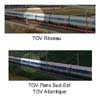
- The Bistro trailer
(identified by a yellow door stripe) is placed differently on a TGV Réseau.
For TGV PSE and Atlantique trainsets, this trailer has its door next to the second
class trailers (identified by a turquoise door stripe), while for the TGV Réseau
the yellow door is next to the first class trailers (identified by a red door stripe).
If it's Red, What is it?
A red TGV trainset definitely belongs to the Thalys service. There are two
similar types of Thalys trainsets, known as PBA and PBKA. The letters stand for
the cities served by each type: P for Paris, B for Brussels, A for Amsterdam, and
K for Köln.
|

- The trainset number
starts with 45 for a PBA trainset, or starts with 43 for a PBKA trainset. See
TGV fleet list for full trainset numbering information.
The number, in white numerals, is found on the sides of the trainset nose.
|

- The nose of the PBKA
trainset is more rounded and there is a single central windshield instead of the
double window windshield of the PBA type.
Last Update: February 2000
|
|
|
|
|
|
|
|
|
|
|
|
|
|
|
|